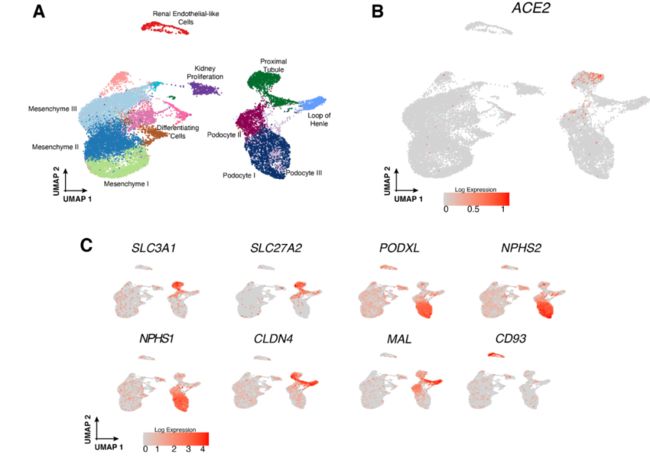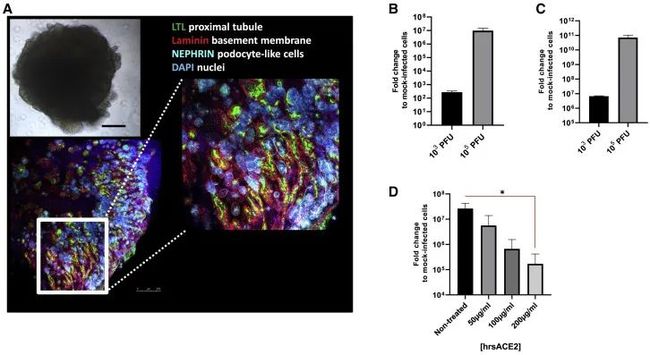复现Cell附图 |类器官的单细胞分析
类器官的单细胞分析
NGS系列文章包括NGS基础、转录组分析 (Nature重磅综述|关于RNA-seq你想知道的全在这)、ChIP-seq分析 (ChIP-seq基本分析流程)、单细胞测序分析 (重磅综述:三万字长文读懂单细胞RNA测序分析的最佳实践教程 (原理、代码和评述))、DNA甲基化分析、重测序分析、GEO数据挖掘(典型医学设计实验GEO数据分析 (step-by-step) - Limma差异分析、火山图、功能富集)等内容。
大家好!我们又见面啦!今儿带领大家复现一个小图。
这篇文章发表于2020年4月24日的Cell主刊,题为Inhibition of SARS-CoV-2 Infections in Engineered Human Tissues Using Clinical-Grade Soluble Human ACE2,其中作者利用类器官的单细胞分析为整个文章做到了锦上添花!
这篇文章发表前,已经有研究报道ACE2(angiotensin converting enzyme 2)是严重急性呼吸综合征冠状病毒(SARS-CoV)的关键受体,并且ACE2可以保护肺脏免受伤害。ACE2现在也被确定为SARS-CoV-2感染的关键受体,并且有人提出抑制这种相互作用可以用于治疗COVID-19患者的想法。但是,人类重组可溶性ACE2(hrsACE2)是否会阻止SARS-CoV-2的生长还尚不清楚。该团队就这一问题研究发现hrsACE2抑制SARS-CoV-2感染呈现剂量依赖性,SARS-CoV-2可以直接感染人血管类器官和肾脏类器官,并且可以被hrsACE2所抑制。文章总结得到hrsACE2可以显著阻断SARS-CoV-2感染的早期阶段。
作者使用单细胞转录组测序的原因非常清晰,就是肾脏类器官在ACE2的表达方面与正常细胞相同,在近端小管和足细胞II细胞亚群中分别存在表达ACE2的细胞,其中近端小管的标记基因为SLC3A1和SLC27A2,足细胞的标记基因为PODXL,NPHS1和NPHS2,说明利用类器官进行实验的可靠性。(说点别的,我第一次接触这个概念时以为类器官指的是在器官体型上会非常相似,很是惊奇,后来得知类器官其实就是将病人的细胞进行培养,具有3D效果,并且能够重现对应器官的部分功能)
下面就是本次要复现的图Figure S2:
Figure S2. Single-Cell RNA-Seq Analysis of Kidney Organoids Reveals ACE2 Expression in Proximal Tubule Cells, Related to Figure 4
(A) UMAP plot displaying the results after unbiased clustering. Subpopulations of renal endothelial-like, mesenchymal, proliferating, podocyte and tubule cells were identified.
(B) Expression of ACE2 projected in the UMAP reduction.
(C) Expression of different cellular markers: SLC3A1, SLC27A2 (Proximal Tubule); PODXL, NPHS1, NPHS2 (Podocyte); CLDN4, MAL (Loop of Henle) and CD93 (Renal Endothelial-like cells).
Figure 4. SARS-CoV-2 Infections of Human Kidney Organoids
(A) Representative images of a kidney organoid at day 20 of differentiation visualized using light microscopy (top left inset; scale bar, 100 μm) and confocal microscopy. Confocal microscopy images show tubular-like structures labeled with Lotus tetraglobus lectin (LTL, in green) and podocyte-like cells showing positive staining for nephrin (in turquoise). Laminin (in red) was used as a basement membrane marker. DAPI labels nuclei. A magnified view of the boxed region shows a detail of tubular structures. Scale bars, 250 and 100 μm, respectively.
(B) Recovery of viral RNA in the kidney organoids at day 6 dpi with SARS-CoV-2. Data are represented as mean ± SD.
(C) Determination of progeny virus. Supernatants of SARS-CoV-2 infected kidney organoids were collected 6 dpi and then used to infect Vero E6 cells. After 48 h, Vero E6 cells were washed and viral RNA assessed by qRT-PCR. The data show that infected kidney organoids can produce progeny SARS-CoV-2 viruses, depending on the initial level of infection. Data are represented as mean ± SD.
(D) Effect of hrsACE2 on SARS-CoV-2 infections kidney organoids. Organoids were infected with a mix of 106 infectious viral particles and hrsACE2 for 1 h. 3 dpi, levels of viral RNA were assessed by qRT-PCR. hrsACE2 significantly decreased the level of SARS-CoV-2 infections in the kidney organoids. Data are represented as mean ± SD (Student’s t test: ∗p < 0.05).
????滑动查看????
测序数据分析介绍
1.工具:Chromium Single Cell 3′ Library
2.筛选:668 < UMIs per cell < 23101, 489 < Genes per cell < 5651 and % UMIs assigned to mitochondrial genes < 50.
3.降维及聚类:PCs=20,Resolution=0.4
4.细胞分型:KIT (Kidney Interactive Transcriptomics webpage )(http://humphreyslab.com/SingleCell/).
首先需要下载rawdata:GSE147863(https://www.ncbi.nlm.nih.gov/geo/query/acc.cgi?acc=GSE147863) (建议使用VPN下载)
加载R包
library(Seurat)使用Read10X_h5读入数据
KidneyOrganoid<-Read10X_h5("KidneyOrganoid_FilteredGeneBCMatrices.h5")建立seurat对象
KidneyOrganoid <- CreateSeuratObject(counts = KidneyOrganoid, project = "KidneyOrganoid_ACE2", min.cells = 3, min.features = 400)
KidneyOrganoid[["percent.mt"]] <- PercentageFeatureSet(KidneyOrganoid, pattern = "^MT-") # 计算线粒体基因比例QC
## QC Metrics Plots
VlnPlot(KidneyOrganoid, features = c("nFeature_RNA", "nCount_RNA", "percent.mt"), ncol = 3,pt.size = 0.3)## Get QC Thresholds
quantile([email protected]$nCount_RNA,c(0.025,0.975))
quantile([email protected]$nFeature_RNA,c(0.025,0.975))QC plots
## QC Plots
plot([email protected]$nCount_RNA,[email protected]$nFeature_RNA,pch=16,cex=0.7,bty="n")
abline(h=c(488,5653),v=c(667,23108),lty=2,lwd=1,col="red")按照QC参数进行过滤
## Filtering based on QC parameters
KidneyOrganoid <- subset(KidneyOrganoid, subset = nFeature_RNA > 488 & nFeature_RNA < 5653 & nCount_RNA > 667 & nCount_RNA < 23108 & percent.mt < 50)归一化及标准化
## Log Normalization
KidneyOrganoid<-NormalizeData(KidneyOrganoid)
## Scale Data
KidneyOrganoid <- ScaleData(KidneyOrganoid, features = rownames(KidneyOrganoid))计算细胞周期
## Cell Cycle Effect
KidneyOrganoid<-CellCycleScoring(KidneyOrganoid,s.features = cc.genes$s.genes,g2m.features = cc.genes$g2m.genes)
KidneyOrganoid <- RunPCA(KidneyOrganoid, features = unlist(cc.genes))
DimPlot(KidneyOrganoid, reduction = "pca",dims = c(1,2),group.by = "Phase")去批次效应
发现细胞周期对细胞分群具有一定的影响,进行去批次:
## SCTransform
KidneyOrganoid<-SCTransform(KidneyOrganoid,vars.to.regress = c("S.Score","G2M.Score","percent.mt","nFeature_RNA"))重新PCA
## PCA
KidneyOrganoid <- RunPCA(KidneyOrganoid, features = VariableFeatures(object = KidneyOrganoid))
DimPlot(KidneyOrganoid, reduction = "pca",dims = c(1,2))
## Some Plots
VizDimLoadings(KidneyOrganoid, dims = 1:2, reduction = "pca")
DimPlot(KidneyOrganoid, reduction = "pca",dims = c(1,2))滚石图
## Selecting PCA Components
ElbowPlot(KidneyOrganoid,ndims = 30)聚类可视化
## Clustering
KidneyOrganoid <- FindNeighbors(KidneyOrganoid, dims = 1:20)
KidneyOrganoid <- FindClusters(KidneyOrganoid, resolution = 0.4)
# Non Linear Dimensional Reduction
KidneyOrganoid <- RunUMAP(KidneyOrganoid, dims = 1:20)
# UMAP plot
colss<-c("#A6CEE3", "#1F78B4", "#08306B", "#B2DF8A", "#006D2C", "#8E0152",
"#DE77AE", "#CAB2D6", "#6A3D9A", "#FB9A99", "#E31A1C", "#B15928",
"#619CFF","#FF67A4","#00BCD8")
DimPlot(KidneyOrganoid, reduction = "umap",label = T,cols=colss)确实是很像哦。。。。再看看基因的表达:
# Feature Plots on interesting genes
FeaturePlot(KidneyOrganoid,c("ACE2"),cols = c("lightgray","red"),order = T)
FeaturePlot(KidneyOrganoid,c("SLC3A1","SLC27A2","PODXL","NPHS2","NPHS1","CLDN4","MAL","CD93"),cols = c("lightgray","red"),order = T)# 寻找高变基因
KidneyOrganoid.markers <- FindAllMarkers(KidneyOrganoid, only.pos = TRUE, min.pct = 0.25, logfc.threshold = 0.25)作者将源代码放在https://github.com/jpromeror/SC_KidneyOrganoid_ACE2 ,大家可以试一试哈!
参考文献
Monteil, Vanessa, et al. “Inhibition of SARS-CoV-2 infections in engineered human tissues using clinical-grade soluble human ACE2.” Cell (2020).
你可能会想看
复现原文(一):Single-cell RNA sequencing of human kidney(step by step)
复现原文(二):Single-cell RNA sequencing of human kidney(step by step)
复现nature communication PCA原图|代码分析(一)
这篇Nature子刊文章的蛋白组学数据PCA分析竟花费了我两天时间来重现|附全过程代码
往期精品(点击图片直达文字对应教程)
|
|
|
|
|
|
|
|
|
|
|
|
|
|
|
|
|
|
|
|
|
|
|
|
|
|
|
|
后台回复“生信宝典福利第一波”或点击阅读原文获取教程合集
![]()
![]()
![]()











